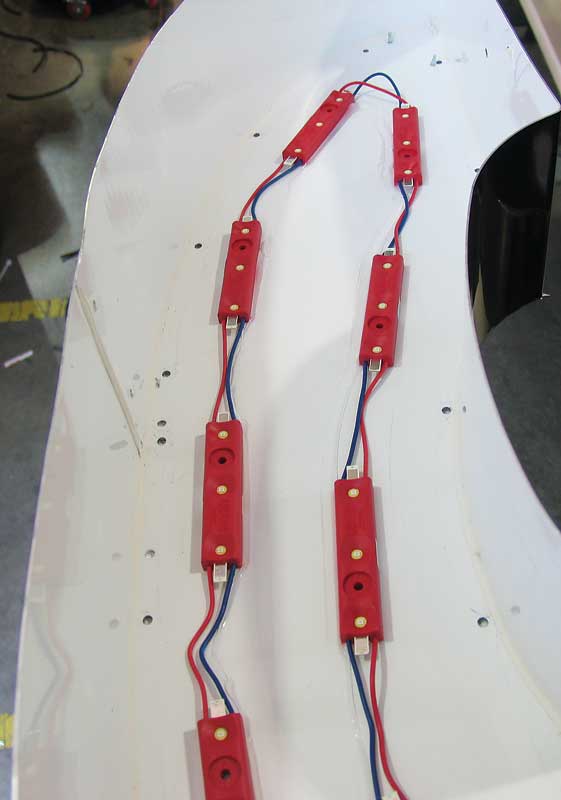Channel Letters: Addressing difficult client expectations
by all | 22 July 2016 8:45 am

Images courtesy Direct Sign Wholesale
By John Baylis
How does one define the term ‘problem client’ in the sign industry? There are many potential issues and irritations a customer can cause for—by way of example—an electrical sign project involving channel letters. The following are some of the warning signs:
- The customer takes up an excessive amount of the sign shop’s time and attention; more than the project actually requires.
- During the project, the customer causes an unusual amount of stress for the shop’s owner and staff.
- The customer is inflexible regarding the appearance of his/her artwork and logo, demanding that the sign must look “exactly like it does on the page.”
- The project provides little chance of any future work; i.e. the location is probably the only one for which the sign will be produced.
It is important to note, by the way, there is nothing inherently wrong with clients not understanding the realities of signmaking. A client’s lack of sign knowledge is not, in itself, a negative factor. Many complaints can be resolved by educating the customer.
Clients who insist on projecting their own lack of understanding on to a sign shop’s team, on the other hand, can quickly become a negative issue. The difference is these problematic customers (a) do not respect signmakers’ competence and (b) will not leave them alone to conduct their work professionally.
Such situations are emblematic of the types of clients with whom signmakers would certainly not be eager to do business. Nevertheless, some sign companies work with them anyway, going through a negative and time-consuming experience.
Sometimes, they do not recognize the problem until it is too late. An alternative business practice would be to implement procedures to spot problem clients in advance and avoid the entire ordeal. The following are a few ideas to consider within this context.

Internally illuminated channel letters rely on minimum stroke widths to accommodate light-emitting diodes (LEDs)
Prior signage experience
Any customer who has previously commissioned the fabrication and installation of an outdoor electrical sign has at least some experience that will be beneficial to his/her working relationship with other signmakers. While this level of experience is not the same as working within the sign industry, the customer will nevertheless have an idea of what is involved in a sign project.
Inexperienced customers, on the other hand, may have no idea how much time and work will be involved when fabricating and installing a set of illuminated channel letters. Some are not even aware of the typical requirement for a sign permit. This lack of experience should be a red flag to signmakers, who may in turn need to explain the realities of the business.
Worse yet are clients whose experience with other types of signs leads them to lump them all together in terms of expectations of how long a project will take. When a client complains, “Our window graphics didn’t take this long,” he/she is wearing rose-coloured glasses with regard to the work involved in a professional outdoor electrical sign installation.
So, it is important to be wary of clients ordering their first-ever outdoor sign, as they may make unrealistic demands regarding the cost, timeframe and materials involved with such a project.

Figures 1 and 2: At the design stage, client-supplied graphics may need to be optimized for sign legibility.
Design knowledge and experience
Another potential problem is the customer who has no knowledge of sign and/or logo design. Just as clients can be naïve regarding how much work is involved with producing and installing a sign, they may be equally out of touch regarding the generation and use of vector artwork files.
The first-timer might even assume the sign shop will automatically supply new artwork among its standard services. This may be fine, provided the expectation is presented ‘on the table’ in advance and the client is made aware of the additional costs involved with the design process.
It also means the shop needs a staff member on hand who is capable of generating an appropriate design. If this is the case, then the company will be well-equipped to take on the additional challenge of creating artwork at the beginning of the project—keeping in mind it could involve multiple revisions, which will add to the project’s timeline.
A new customer may even assume a hand-drawn sketch on a sheet of paper counts as a design file and, once that sheet has been handed to the sign shop, the design stage of the project is complete! This is certainly not the case and needs to be explained at the outset.
Graphic files
Some customers, on the other hand, will provide prepared graphic files that look fine in print, but do not translate well into signage. Their logo, for example, might use a custom font featuring letter strokes that are far too thin for channel letters, which necessarily entail minimum stroke widths to accommodate the physical realities of the letter materials and illumination. Alternatively, the logo might include artistic elements that are impractical to reproduce in signage, as the resulting design would be difficult to read (see Figures 1 and 2).
Yet another potential issue is artwork with overlapping graphic elements. Again, these might provide an appealing appearance in print, but are not feasible to reproduce in a set of channel letters. Even as a logo box, the design could cause legibility problems.
These are all reasons for signmakers to be wary when a new client proudly proclaims, “Our logo is all set to go!” While he/she may not realize it, in many cases a graphic designer has created artwork without consideration of certain applications, particularly signage. So, the design may involve odd shapes, layered elements and other complications that would prohibit a straightforward translation into an effective sign design.
With that in mind, when the client explains the file is ready, the signmaker should insist on seeing it first. A ready-to-go file may not be ready at all.

When a client has multiple locations, the initial work invested in the original sign design can pay off with future business.
Potential future business
As mentioned, another factor to consider is the potential for future sign sales to the same customer. There is certainly nothing wrong with doing work for a single-location business, but if that business is a problem client for other reasons, then the lack of potential for similar future sales can certainly compound the frustration for the sign shop.
That said, such potential can be difficult to measure, as a single-location business could end up opening additional locations in the future. Also, a single-location client can be highly valuable in terms of referrals.
In any case, if a signmaker chooses to work with time-consuming clients rather than avoid them, then a key factor in the payoff of that investment of time is the possibility of multiple future installations of the same—or very similar—signs.
Levels of decision-making
Another issue is the client who must go through multiple layers of decision-making before providing design approval to the sign shop. Design approval by committee and/or by other inexperienced contacts who insist on participating in the process can easily result in project delays. A concept that is acceptable to one person, after all, may not please another, which can lead to an ever-
changing design. For this reason, timelines need to be set in advance.
Project budgeting
The client who will not state a sign project budget in advance is another major red flag. This often means the actual budget available for the job is much lower than what the client’s desired sign would actually cost.
A client’s unwillingness to state a project budget is also yet another issue of experience and knowledge. Misperceptions of the amount of time and labour involved in producing and installing an outdoor electrical sign can carry over into misperceptions of estimated project costs.
Advance questioning
To help sign shops spot and either educate or avoid problem clients, it is important to ask the right questions in advance:
- Is your new sign already designed?
- If not, who will design it?
- If the sign has yet to be designed, are you the only person who must approve it?
- If not, who else must approve the design?
- If you already have a design, who created it and may we see the file?
- Is this the first time this sign will be produced or has it already been installed at another location?
- What is your budget for this project?
- What is your timetable to have this project completed and does it involve a hard deadline (such as the grand opening of a new business)?
- Is this the only location for which this sign will ever be needed?
Watching for red flags as the client answers these questions is very important, as problem clients can easily cost a sign shop more—in time, labour, staff morale and headaches—than it will actually make from the project.
John Baylis is marketing director for Direct Sign Wholesale, which produces channel letters. For more information, contact him via e-mail at jb@directsignwholesale.com[1].
- jb@directsignwholesale.com: mailto:jb@directsignwholesale.com
Source URL: https://www.signmedia.ca/channel-letters-addressing-difficult-client-expectations/